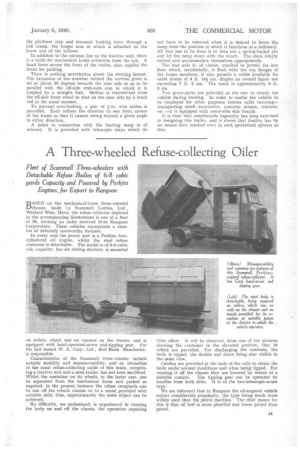A Three-wheeled Refuse-collecting Oiler
Page 27

If you've noticed an error in this article please click here to report it so we can fix it.
Fleet of Scammell Three-wheelers with Detachable Refuse Bodies of 6-8 cubic yards Capacity and Powered by Perkins Engines, for Export to Rangoon BASED on the mechanical-horse three-wheeled chassis, made Ly Scammell Lorries, Ltd., Watford West, Herts, the refuse collector depicted in the accompanying illustrations is one of a fleet of 36, forming an order received from Rangoon Corporation. These vehicles incorporate a number of definitely noteworthy features.
In every case the power unit is a Perkins fourcylindered oil engine, whilst the steel refuse container is detachable. The model is of 6-8 cubic yds. capacity, has six sliding shutters, is mounted
on rollers, which rest on runners on the chassis, and is equipped with hand-operated-screw end-tipping gear. For the last named W. E. Cary, Ltd., Red Bank, Manchester, is responsible.
Characteristics of the Scarnmell three-wheeler include notable mobility and manceuvrability, and an attraction of the usual refuse-collecting outfit of this make, comprising a tractive unit and a semi-trailer, has not been sacrificed. Whilst the container on its wheels, in the latter case, can be separated from the mechanical horse and parked as required, in the present instance the refuse receptacle can be run off the vehicle chassis on to a stand provided with suitable rails; thus, approximately the same object can be achieved.
No difficulty, we understand, is experienced in running the body on and off the chassis, the operation requiring little effort. It will •be observed, from one of the pictures showing the container in the elevated position, that 10 rollers are provided. For discharging the contents, the body is tipped, the double end doors being also visible in the same view.
Catches are provided at the ends of the rails to retain the body under normal conditions and when being tipped. For running it off the chassis they are lowered by means of a suitable control. The tipping gear can be operated by handles from both sides. It is of the two-telescopic-screw type.
We are informed that in Rangoon the oil-engined vehicle enjoys considerable popularity, the type being much more widely used than the petrol machine. The chief reason for this is that oil fuel is more plentiful and lower priced than petrol.




























































